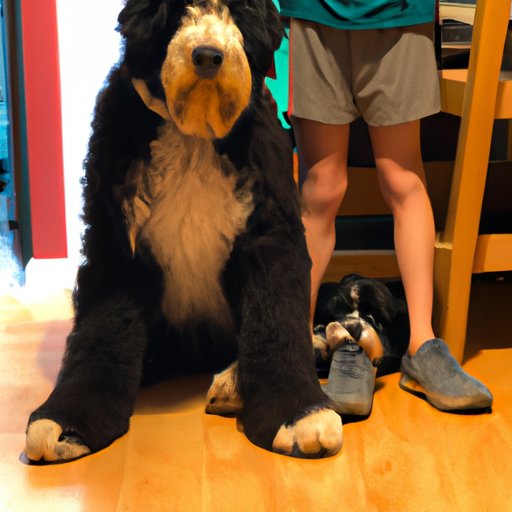Introduction
Bernedoodles are a relatively new hybrid breed of dog that have become increasingly popular in recent years. As their name suggests, they are a cross between a Bernese Mountain Dog and a Poodle. They are known for being friendly, intelligent, and loyal companions, as well as having low-shedding coats. But just how big do Bernedoodles get? In this article, we will explore the size of Bernedoodles, including factors that influence their size, common size ranges, growth rate, and what to expect when you bring one home.
Exploring the Size of Bernedoodles: A Breeders Guide
When it comes to the size of Bernedoodles, there are several factors that need to be taken into consideration. These include the size of the parents, the type of Poodle used in the cross (Standard, Miniature, or Toy), and the amount of exercise and nutrition the puppy receives. Each of these factors will play a role in determining the size of the Bernedoodle, so it is important to understand them before deciding on a pup.
When it comes to the size of the parents, it is important to note that Bernese Mountain Dogs range from 22-29 inches in height, while Poodles come in three different sizes: Standard (15-20 inches), Miniature (11-15 inches), and Toy (under 11 inches). Therefore, depending on the size of the parents, the resulting Bernedoodle could range from very small to quite large.
In terms of nutrition and exercise, it is important to ensure that your Bernedoodle pup is getting enough of both. Proper nutrition will help your pup grow at a healthy rate, while exercise will help keep them fit and strong. It is also important to note that proper nutrition and exercise can have a positive effect on the size of a Bernedoodle, as they can help promote growth.
What is the Typical Size Range of a Bernedoodle?
The size of a Bernedoodle will depend on the size of the parents, as well as the type of Poodle used in the cross. Generally speaking, there are three common size ranges for Bernedoodles: Standard, Miniature, and Toy. Let’s take a closer look at each of these.
Standard Bernedoodle
Standard Bernedoodles are a cross between a Standard Poodle and a Bernese Mountain Dog. This combination usually results in a larger Bernedoodle, with heights ranging from 20-29 inches. They typically weigh between 45-90 pounds.
Miniature Bernedoodle
Miniature Bernedoodles are a cross between a Miniature Poodle and a Bernese Mountain Dog. This combination usually results in a smaller Bernedoodle, with heights ranging from 15-22 inches. They typically weigh between 25-50 pounds.
Toy Bernedoodle
Toy Bernedoodles are a cross between a Toy Poodle and a Bernese Mountain Dog. This combination usually results in a very small Bernedoodle, with heights ranging from 10-15 inches. They typically weigh between 15-25 pounds.

Growing Up: Understanding How Big a Bernedoodle Gets
Once you have chosen your Bernedoodle pup, it is important to understand how they will grow. Generally speaking, Bernedoodles reach their full adult size by 12-18 months of age. However, this timeline can differ depending on the individual pup and their environment.
One of the most important factors in determining how big a Bernedoodle gets is proper nutrition and exercise. Puppies need a balanced diet that includes essential vitamins and minerals to help them grow at a healthy rate. Additionally, puppies should get plenty of exercise to promote muscle development and help them reach their full potential. If a puppy is not getting the proper nutrition and exercise, they may not reach their full adult size.

The Pros and Cons of Owning a Large Bernedoodle
When it comes to owning a large Bernedoodle, there are both advantages and disadvantages. On the plus side, a large Bernedoodle can be an excellent guard dog and provide protection for their family. Additionally, they can make great hiking or jogging partners due to their size and strength. On the other hand, large Bernedoodles require more space and can be difficult to manage in smaller homes or apartments.
It is also important to note that large Bernedoodles may require more exercise than smaller breeds, which can be difficult to fit into a busy lifestyle. Additionally, larger dogs require more food, which can be expensive. Finally, large Bernedoodles may have difficulty traveling in cars or airplanes, as they may not fit in some vehicles.

What to Expect in Terms of Size When You Bring Home a Bernedoodle
When you bring home a Bernedoodle pup, it is important to have realistic expectations in terms of size. While it is impossible to predict exactly how big a Bernedoodle will get, there are a few ways to estimate their adult size.
One way to estimate the size of a Bernedoodle is to look at their parents. Generally speaking, a Bernedoodle pup will reach about 80% of their adult size by the time they are 1 year old. Additionally, puppies tend to grow at a steady rate until about 6 months of age, then slow down until reaching their full size at around 18 months of age.
Another way to estimate the size of a Bernedoodle is to look at their littermates. Bernedoodles from the same litter tend to be similar in size, so comparing your pup to their siblings can give you an idea of how big they will get.
Conclusion
In conclusion, Bernedoodles are a unique hybrid breed of dog that have become increasingly popular in recent years. When it comes to their size, there are several factors that can influence how big a Bernedoodle gets, including the size of the parents, the type of Poodle used in the cross, and the amount of nutrition and exercise the pup receives. Generally speaking, there are three common size ranges for Bernedoodles: Standard, Miniature, and Toy. Additionally, Bernedoodles reach their full adult size by 12-18 months of age and should be given proper nutrition and exercise to ensure they grow at a healthy rate. Finally, it is important to have realistic expectations in terms of size when bringing home a Bernedoodle pup and to consider the pros and cons of owning a large Bernedoodle before making a decision.
Overall, Bernedoodles are a wonderful breed of dog that make great companions. With the right care and attention, they can be a loyal and loving addition to any family. So if you’re looking for a pup that is sure to bring joy, a Bernedoodle might be the perfect fit!
(Note: Is this article not meeting your expectations? Do you have knowledge or insights to share? Unlock new opportunities and expand your reach by joining our authors team. Click Registration to join us and share your expertise with our readers.)
